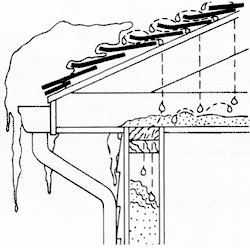Small Home Gazette, Winter 2011
Damn Ice Dams
Media coverage of ice dams on the roofs of Twin Cities area homes has stacked up almost as high as the snow we received in December. Record snowfall, some warmer days, and under-insulated roofs have produced a bumper crop of ice dams.
 Ice dams form when the upper portions of a roof heat up above 32º F under a blanket of snow. The melt water flows down the slope and re-freezes on the roof over the cooler eaves. Gradually an ice dam builds, trapping water behind it. The trapped water seeps under the shingles to leak into the home, damaging insulation, walls and ceilings.
Ice dams form when the upper portions of a roof heat up above 32º F under a blanket of snow. The melt water flows down the slope and re-freezes on the roof over the cooler eaves. Gradually an ice dam builds, trapping water behind it. The trapped water seeps under the shingles to leak into the home, damaging insulation, walls and ceilings.
Solving the ice dam problem involves keeping the roof cool. Unfortunately, many older homes don’t have enough insulation or there are gaps in the insulation—usually around light fixtures, flue pipes, skylights or chimneys. Anything that penetrates the cavity between the space between your ceiling and the roof can create a leak that lets the roof warm up.
Sealing those leaks is the first and best step toward eliminating ice dams. Unfortunately, a long-term solution can only be completed during warm weather. So, use the remaining weeks of winter to learn about ice dams and plan your course of action this summer.
Some of you may recall an article on ice dams that I wrote for this newsletter about 10 years ago, in which I recounted the steps we took to eliminate ice dams while remodeling our St. Paul home. I continue to rake snow off the roof each year as a preventative measure. I’m pleased to report we haven’t had any problems since—but I’ve probably just jinxed us. That article is on the Bungalow Club’s website in the Newsletter section at https://bungalowclub.org/newsletter/articles/.
We also recommend two sources for more detailed information about ice dams and what you can do about them. The first is a recently revised webpage on ice dams from University of Minnesota Extension: http://www.extension.umn.edu/











